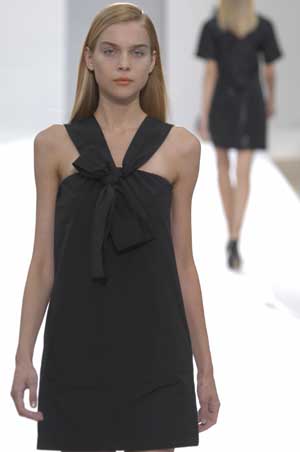|
fashion: overview
 Premium economy Premium economy

Like the premium economy class on airlines,
Cos is Hennes
& Mauritz’s way of extending its market upwards
photographed by Chris Moore
HENNES & MAURITZ
might be reinventing the wheel with its Cos line. The idea: create
a value line which sits above the regular H&M
range. But is this not where many other labels have rested for years?
As an idea, it’s sound: occupy the cheaper
end of the market, and after many years, when the market is right,
introduce a more premium range. Honda did it with Acura and Toyota
with Lexus. The big fashion labels go downward from their luxury
positions: Hugo Boss with Boss, for example. World,
as we noted here in Lucire, diversified into corporate clothing
in a collaboration with Deane Apparel.
After exploring the idea of accessible luxury
with its collaborations with Karl Lagerfeld and Stella
McCartney, a slight move upmarket for H&M
can assure growth for the Swedish-HQed
group.
Æsthetically, the Cos collection is a bit
more colourful, a little less hippie-chic, than some of the core
H&M designs. But it’s not
a huge departure for the company: this is still ready-to-wear stuff
that’s extremely casual and fun. In other words, it should
sell well: it’s well positioned with inoffensive mass-market
appeal.
The company itself says Cos—officially spelt
by H&M in all caps—has a
‘commitment to both design and affordability, where meticulously
produced garments [do] anything but skyrocket in price’. Its
première collection is inspired by the 1950s and 1960s, using
clean lines with some nods to the volume trend seen on catwalks
for the autumn season. The modernist look is in line with consumer
expectations as 2007 comes to a close, something we forecast as
a revived design movement as early as January 2004. Another check
mark for H&M.
The company claims to have a more individual
colour palette (‘from signature crisp white, soft sandy neutrals,
powdery blushes and Mod-ish pastels [sun-faded coral; melon yellow
and pale mint] through to dramatic darks [oil slick purple, midnight
navy, tobacco brown and black].’ Textural finishes include
washed, waxed and tightly woven surfaces.
Despite this, those seeking “premium H&M”—just
as those who fly premium economy on airlines—will still find
the range fairly recognizable, as it is created internally by the
company.
The brand is in its own stores, initially in
the UK, Germany, the Netherlands and
Belgium. København and Antwerpen are next on the list, along
with a second store in Berlin.
Add
to Del.icio.us | Digg
it | Add
to Facebook
|

